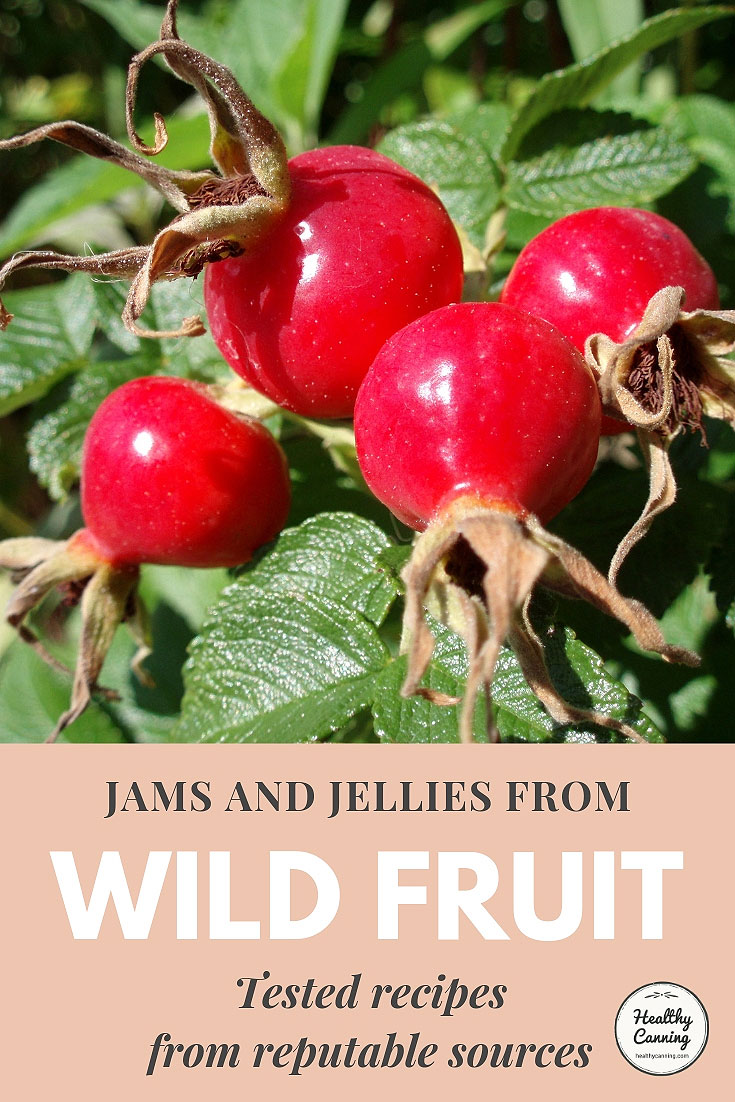
Rose hips. Morn / Wikimedia / 2010 / CC BY-SA 3.0
Many delicious preserves can be made using wild fruits.
Here is a list of resources for recipes that will give you safe, high-quality results.
Cautions
Be sure that either (a) you know how to clearly identify the wild fruits you are interested in preserving, or (b) have with you someone that can, or (c) that the fruits you are purchasing at a farmer’s market, etc., were picked by a genuinely knowledgeable person. Many wild fruits are not safe for human consumption, and preserving them does not magically change that. For instance, current research indicates that the native blue elderberry is well within high pH levels to use all your traditional canning recipes. American and European elderberries are not safe to can in any form, red elderberries (Sambucus Callicarpa) contain traces of the alkaloid sambucine and hydrocyanic acid (the same as is in apple seeds) and can cause stomach distress in varying degrees of severity.
Follow the recipes. Don’t be tempted to cut back the sugar or pectin in such recipes. Instead, seek out recipes already tested for lower-sugar alternatives.
Page updated as of February 2019.
University of Minnesota
- Blackberry and huckleberry jam
- Blackberry Syrup
- Blueberry Syrup
- Chokecherry Jelly
- Chokecherry Syrup
- Cranberry Jelly
Gooseberry Jam - Gooseberry Jelly
- Grape and Crabapple Jelly
- Pincherry Jelly
- Pincherry Syrup
- Rosehip and Rhubarb Jam
- Rosehip Jelly
- Sandcherry Jelly
North Dakota State University
- Apple or Crabapple Jelly
- American Black Currant – Golden or Missouri
- Blackberry-Huckleberry Jam
- Blackberry Syrup
- Blueberry Syrup
- Buffalo Berry or Bull Berry Jelly
- Buffalo Berry and Crabapple Jelly
- Chokecherry Jelly With Liquid Pectin
- Chokecherry Jelly With Powdered Pectin
- Elderberry Jelly
- Gooseberry Jam
- Grape Plum Jelly
- Ground Cherry Jam
- Ground Cherry Marmalade
- Ground Cherry Preserves
- High Bush Cranberry Juice
- High Bush Cranberry Jelly
- Juneberry Jam
- Pin Cherry or Wild Red Cherry Jelly
- Pin Cherry and Crabapple Jelly
- Rose Hip Jam
- Rose Hip and Apple Jelly
- Sand Cherry Jelly
- Sand Cherry Jam
- Wild Grape Jelly
- Wild Plum Jam
- Wild Plum Jam (Freezer Jam)
Further Reading
Cascio, Julie and Marci Johnson. Wild Roses. University of Alaska Fairbanks Extension Service. FNH-00114. Reviewed October 2015. [Various products from rose petals and rose hips]
Garden-Robinson, Julie. Jams and Jellies from Native (Wild) Fruits. North Dakota State University. FN1423. Reviewed January 2015.
Garden-Robinson, Julie. Jams and Jellies from North Dakota Fruits. North Dakota State University. FN590. Reviewed January 2018.
Paul, Lynn. Making Jams, Jellies and Syrups including with wild Montana berries and fruit. Montana State University Extension. MT200904HR. 2017.
Preserving Foods: Wild Berries and Fruits. Oregon State University Extension Service. SP 50-536. Revised Feb. 2013 [Includes Red, black and evergreen huckleberries, Western huckleberries, Bog cranberries, Oregon grapes, Himalayan berries, Evergreen berries, Salal berries, Blue Elberberries, Salmonberries, Thimbleberries.]

Leave a Reply